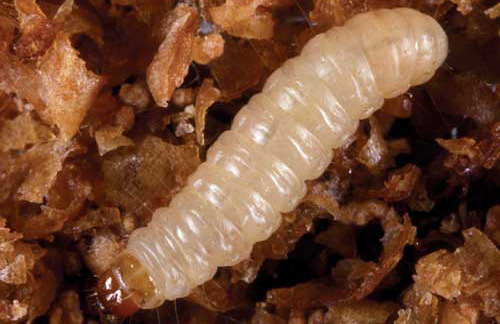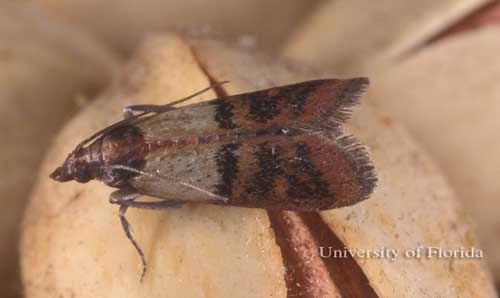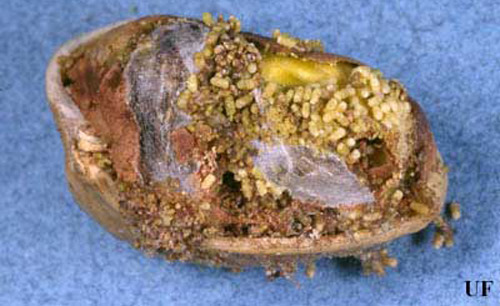common name: Indianmeal moth
scientific name: Plodia interpunctella (Hübner) (Insecta: Lepidoptera: Pyralidae)
Introduction - Distribution - Description - Life Cycle - Damage - Monitoring - Management - Selected References
Introduction (Back to Top)
The Indianmeal moth, Plodia interpunctella (Hübner), is a very common household pest, feeding principally on stored food products. In fact, it has been called the most important pest of stored products commonly found in American homes or grocery stores. The larvae are general feeders and can be found in grain products, seeds, dried fruit, dog food, and spices. The Indianmeal moth received its common name from the United States where it was found to be a pest of meal made of "Indian corn" or maize.
Figure 1. Larva of the Indianmeal moth, Plodia interpunctella (Hübner). Photograph by Lyle Buss, University of Florida.
Distribution (Back to Top)
This insect is found in a wide range of climates in stored products and food storage facilities around the world. It is very common in Florida, where it also lives successfully outdoors.
Description (Back to Top)
Eggs: Eggs of the Indianmeal moth appear grayish white and range in length from 0.3 to 0.5 mm. Eggs are oviposited singly or in clusters, and are generally laid directly on the larval food source.
Larvae: There are five to seven larval instars. Their color is usually off-white, but has been observed to be pink, brown or almost greenish, depending on the food source. The mature larvae are about 1/2 inch (1.27 cm) in length. They have five pairs of well-developed prolegs that help them move considerable distances to pupate.
Pupae: The larvae pupate either in a silken cocoon or unprotected. The pupae are 1/4 to 2/5 inch long (6 to 11 mm) and are pale brown in color. Pupation takes place away from the infested material. In fact, late instar larvae can travel such distances that they are often mistaken for clothing pests. Within the pantry, small larvae often climb to other shelves before pupating. This misleads people trying to find the source of the infestation.
Figure 2. Pupa of the Indianmeal moth, Plodia interpunctella (Hübner). The larva crawled up two shelves and then onto a stack of food envelopes before pupating on the inside of a military C-ration toilet-paper packet in the senior author's house. This shows how larvae have the ability to migrate to distant locations and, thus, confuse identification for the source of the infestation. Photograph by Lyle Buss, University of Florida.
Figure 3. Pupal case of the Indianmeal moth, Plodia interpunctella (Hübner). Found in the senior author's pantry, the larva pupated on the bottom edge of a soup can two shelves up from the actual infestation. All pantry goods must be examined carefully to eliminate the next generation of adults, which can fly and thus distribute the infestation further. Photograph by Lyle Buss, University of Florida.
Figure 4. Remains of a pupal case of the Indianmeal moth, Plodia interpunctella (Hübner). The larva pupated inside the lid of a cardboard container one pantry shelf up from the actual infestation in the senior author's house. This demonstrates how difficult it might be to eliminate an infestation even after it has been discovered. Photograph by Lyle Buss, University of Florida.
Figure 5. Remains of a pupal case of the Indianmeal moth, Plodia interpunctella (Hübner). The larva pupated on the side of a stack of paper cups in the senior author's kitchen. Photograph by Lyle Buss, University of Florida.
Adults: Adults are a common sign of an infestation. Flying adults often appear to be fluttering instead of maintaining a direct line of flight. They are attracted to light and may move to distant rooms in the house away from the infestation. As a result, they are also commonly mistaken for clothing pests. Adults do not feed. However, even though not necessary for egg production, adults have been reported to be interested in fruit juice and sugar baits (Kullberg, personal communication).
Adults are about 1/2 inch (12.7 mm) long with a wing span of about 5/8 inch (16 to 20 mm). The forewings of this moth are reddish brown with a copper sheen on the outer two thirds and gray on the inner third. At rest the wings are held roof-like over the body. The head and thorax of the moth appears gray and the posterior brown, with a coppery sheen.
Figure 6. Adult female Indianmeal moth, Plodia interpunctella (Hübner). Photograph by Lyle Buss, University of Florida.
Life Cycle (Back to Top)
A life cycle can be completed in 27 to 305 days. A single female can lay up to 400 eggs after mating. The mating and laying of eggs occurs about three days after adult emergence. The eggs can be laid singly or in clusters, and are generally oviposited directly on the larval food source. The eggs hatch in seven to eight days at 20°C and three to four days at 30°C. Upon hatching, the larvae begin to disperse and within a few hours can establish themselves in a food source. The larvae can complete their development in six to eight weeks at temperatures from 18 to 35°C. The number of larval instars varies from five to seven (depending on the food source and the temperature). The pupal stage can last from 15 to 20 days at 20°C and seven to eight days at 30°C.
Damage (Back to Top)
The larvae are surface feeders. Most of the "damage" to stored products occurs when the larvae spin massive amounts of silk that accumulate fecal pellets, cast skins, and egg shells in food products. The damage to stored products due to this contamination exceeds the amount of food eaten by the insects. Homeowners and managers of food processing plants, warehouses, groceries and granaries should be alert for signs of infestation.
Figure 7. An infestation of Indianmeal moth, Plodia interpunctella (Hübner), in a jar of pistachio nuts. It was later determined by the senior author that the nuts were purchased from a commercial supermarket that had an infestation in a bin of bulk foods. One or more infested nuts were brought home. The lid of the jar was slightly loose, which allowed several generations of Indianmeal moths to reproduce, and eventually larvae and adults escaped to pupate and spread the infestation. If the jar had been tightly closed, the infestation would have died, either from lack of air or from a buildup of moisture that would have allowed the development of fungus to destroy the larvae and adults. Observe the frass (insect fecal waste) on the outside of the nuts, as well as the webbed pupal cases in the center of the photograph. A few adults are also visible. Photograph by Lyle Buss, University of Florida.
Figure 8. Close-up of a nut infested with Indianmeal moth, Plodia interpunctella (Hübner). Notice the frass and pupal cocoon. Photograph by Lyle Buss, University of Florida.
Monitoring (Back to Top)
Monitoring and sampling can be accomplished with pheromone sticky traps. In some cases of low-level infestations, traps can be used for control as well. Traps are also useful in timing and evaluation of control procedures. In a study of pheromone trap effectiveness in attracting Indianmeal moths, traps containing (Z,E)-9, 12-tetradecadien-l-yl-acetate (ZETA) proved useful in monitoring populations. One drawback of the pheromone sticky trap seems to be that population size and number trapped affect their effectiveness. For example, if large number of moths are in the trap, the ability to capture more moths decreases. The continued use of sticky traps (with pheromones) could lead to improved control programs and less incidence of insects in stored products on grocery shelves.
Management (Back to Top)
Sanitation: Elimination and exclusion are key elements in controlling pest populations of this moth. If a population is discovered, all infested food must either be discarded or treated. Any susceptible food source should be placed in sealed containers. Dog food and bird seed usually are overlooked as infestation sites, and these items should also be kept in sealed containers. All stored food products brought home from the grocery store should be examined for the tell-tale "white worms" and webbing, otherwise the infestion will spread to other stored products. In most cases, infested materials, especially small amounts, should be discarded and removed quickly from the premises. While it is advisible in warmer areas to keep meals and flours under refrigieration until used, this precaution is not always followed by homeowners and others.
Freeezing and Heating: If an infestation is detected, freezing the product for several days has proven to be an effective control measure. Infested products should be kept in temperatures of 0°F (-18°C) until the cold penerates all areas of the packaging. Four days should kill the life stages of most stored product pests. Heat will also kill stored product pests if temperatures of 130°F to 150°F (54°C to 66°C) are maintained for 24 hours in infested facilities. Small quantities of infested materials can be treated in their original packaging or the loose material may be placed in a shallow pan. Then heat the material for 150°F (66°C) for 20 minutes. However, one reference advises propping the oven door open to keep it from getting too hot (Mallis 2004).
Chemical control: Numerous insecticides have been used to control Indianmeal moth populations, but effectiveness is limited. In a study evaluating the effectiveness of an insect growth regulator, it was found that even after treatment with these chemicals, Indianmeal moths were in corn storage bins. In an additional study using the same insect growth regulator, it was found that at rates of 5 and 10 ppm no control of fifth instar larvae was accomplished. Only at 20 to 30 ppm was control of fifth instar larvae observed. Studies show that resistance increased with increasing selective pressure. Resistance was also observed in studies performed with the microbial insecticide Bacillus thuringiensis (Bt). Resistance was just as likely with exposure to single strains of Bt as with mixtures of sequences of the insecticide. Resistance, once achieved, appeared to be inherited as a recessive trait, and with time was observed as genetically stable.
Biological control: Population suppression has been observed in the laboratory using egg and larval parasites. Both the larval parasite, Bracon hebetor (Hymenoptera: Braconidae) and the egg parasite, Trichogramma pretiosum (Hymenoptera: Trichogrammatidae) have demonstrated moth population suppression. When the parasites were used in combination, an 84.3 percent suppression was observed. Trichogramma pretiosum acting alone offered a 37.3 percent suppression rate while Bracon hebetor provided a 66.1 percent suppression rate.
Selected References (Back to Top)
- Arthur FH, Highland HA, Mullen MA. 1991. Efficiency and longevity of two commercial sex pheromone lures for Indianmeal moth and almond moth (Lepidoptera: Pyralidae). Journal of Economic Entomology 26: 64-68.
- Arthur FH, Simonaitis RA, Throne JE, Zehner JM. 1990. Evaluation of chlorpyrifos-methyl and chlorpyrifos-methyl plus methoprene as protectants of stored corn: small bin tests. Journal of Economic Entomology 83: 1114-1121.
- Arthur F. 1989. Pest of stored peanuts: toxicity and persistence of chlorpyrifos-methyl. Journal of Economic Entomology 82: 660-664.
- Arthur F, Halliday WR, Zettler JL. 1988. Insecticide resistance among populations of almond moth and Indianmeal moth (Lepidoptera: Pyralidae) in stored peanuts. Journal of Economic Entomology 81: 1283-1287.
- Beeman RW, McGaughey WH. 1988. Resistance to Bacillus thuringiensis in colonies of Indianmeal moth and almond moth (Lepidoptera: Pyralidae). Journal of Economic Entomology 81: 28-33.
- Bongers AJ, Brandi DG, Hinsch RT, Hoogendorn H, Soderstrom EL. 1987. Detecting adult Phyctinae (Lepidoptera: Pyralidae) infestations in a raisin-marketing channel. Journal of Economic Entomology 80: 1229-1232.
- Brower JH, Press JW. 1990. Interaction of Bracon hebetor (Hymenoptera: Braconidae) and Trichogramma pretosium (Hymenoptera: Trichogrammatidae) in suppressing stored-product moth populations in small inshell peanut storages. Journal of Economic Entomology 83: 1096-1101.
- Brower JH. 1988. Population suppression of the almond moth and the Indianmeal moth (Lepidoptera: Pyralidae) by release of Trichogramma pretiosum (Hymenoptera: Trichogrammatidae) into simulated peanut storages. Journal of Economic Entomology 81: 944-948.
- Dowdy AK, Hagstrum DW, Lippert GE. 1994. Early detection of insects in stored wheat using sticky traps in bin headspace and prediction of infestation level. Environmental Entomology 23: 1241-1244.
- McGaughey WH, Tabashnik BE. 1994. Resistance risk assessment for single and multiple insecticides: responses of Indianmeal moth (Lepidoptera: Pyralidae) to Bacillus thuringiensis. Journal of Economic Entomology 87: 834-841.
- Smith EH, Whitman RC. 1992. Field Guide to Structural Pests. National Pest Management Association, Dunn Loring, VA.
- VanRykeghem A. 2004. Stored Product Pests. In Handbook of Pest Control. Hedges SA (editor). 9th Edition. GIE Media. Cleveland. 1397 pp.







